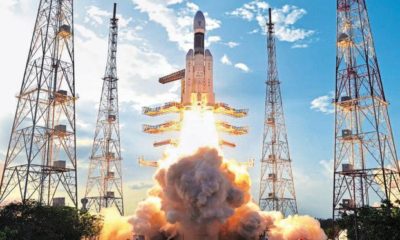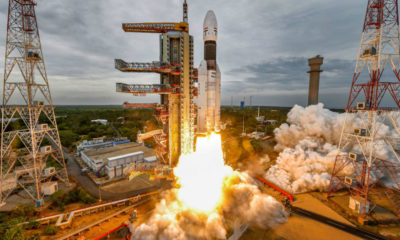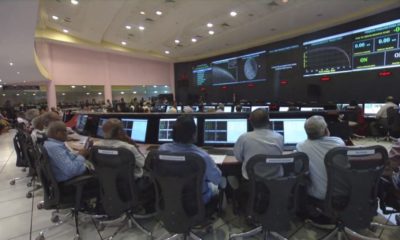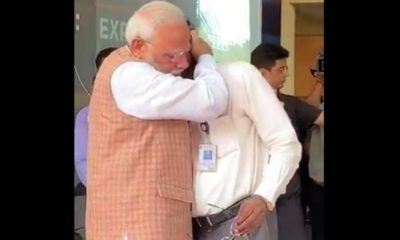Feature
India all set to launch fourth navigation satellite today

Chennai: An Indian rocket is readying to blast off at 5.19 p.m. on Saturday carrying the country’s fourth navigation satellite IRNSS-1D from the Sriharikota rocket port, the Indian space agency said .
The countdown is progressing smoothly with the rocket’s second stage fuelled up early Saturday morning.
The 59-and-a-half hour countdown began on March 26 at 5.49 a.m.
Around 20 minutes into the flight, the rocket – the Polar Satellite Launch Vehicle (PSLV-C27) – would eject the Indian Regional Navigation Satellite System (IRNSS)-1D at around 506 km above the earth.
From there the satellite would further be moved to its final position.
India has so far launched three regional navigational satellites as part of a constellation of seven satellites to provide accurate position information service to users across the country and the region, extending upto an area of 1,500 km.
The three satellites launched earlier have been integrated with the ground stations and are working well.
Once IRNSS-1D also gets integrated, then the Indian satellite navigation system would start transmitting navigation signals. This meets the minimum number of satellites necessary for enabling a navigation receiver to compute its position.
Thus with IRNSS-1D functioning in orbit, proof-of-concept of an independent regional navigation satellite system over India can be established.
According to Indian Space Research Organisation (ISRO) officials, two more navigation satellites are expected to be launched in 2015 and the seventh and the last one of the system in all probability would go up early 2016.
Full navigation services are expected to be offered from mid-2016, according to the officials.
Queried about the ground segment infrastructure, a senior official at ISRO not wanting to be named told that good part of that is in place and the balance would be ready soon.
He said the IRNSS system is unique as it consists of only seven satellites while other systems have more than 20 satellites.
However, while other systems are global, Indian system is regional in nature.
Nevertheless, ISRO official claims that India can replace the US GPS with Indian system when full fledged operations begin.
The fully operational system is expected to provide accurate position information service to users across the country and the region, extending up to an area of 1,500 km.
While ISRO is silent on the navigation systems strategic application, it is clear that IRNSS will be used for defence purposes as well.
Each satellite costs around Rs.150 crore and the PSLV-XL version rocket costs around Rs.130 crore. The seven rockets would involve an outlay of around Rs.910 crore.
The entire IRNSS constellation of seven satellites is planned to be completed this year itself.
The first satellite IRNSS-1A was launched in July 2013, the second IRNSS-1B in April 2014 and the third on October 16, 2014.
Once the regional navigation system is in place, India need not be dependent on other platforms.
Entertainment
Meghalaya Reserves Legalized Gambling and Sports Betting for Tourists

The State Scores Extra High on Gaming-Friendly Industry Index
Meghalaya scored 92.85 out of 100 possible points in a Gaming Industry Index and proved to be India’s most gaming-friendly state following its recent profound legislation changes over the field allowing land-based and online gaming, including games of chance, under a licensing regime.
The index by the UK India Business Council (UKIBC) uses a scale of 0 to 100 to measure the level of legalisation on gambling and betting achieved by a state based on the scores over a set of seven different games – lottery, horse racing, betting on sports, poker, rummy, casino and fantasy sports
Starting from February last year, Meghalaya became the third state in India’s northeast to legalise gambling and betting after Sikkim and Nagaland. After consultations with the UKIBC, the state proceeded with the adoption of the Meghalaya Regulation of Gaming Act, 2021 and the nullification of the Meghalaya Prevention of Gambling Act, 1970. Subsequently in December, the Meghalaya Regulation of Gaming Rules, 2021 were notified and came into force.
All for the Tourists
The move to legalise and license various forms of offline and online betting and gambling in Meghalaya is aimed at boosting tourism and creating jobs, and altogether raising taxation revenues for the northeastern state. At the same time, the opportunities to bet and gamble legally will be reserved only for tourists and visitors.
“We came out with a Gaming Act and subsequently framed the Regulation of Gaming Rules, 2021. The government will accordingly issue licenses to operate games of skill and chance, both online and offline,” said James P. K. Sangma, Meghalaya State Law and Taxation Minister speaking in the capital city of Shillong. “But the legalized gambling and gaming will only be for tourists and not residents of Meghalaya,” he continued.
To be allowed to play, tourists and people visiting the state for work or business purposes will have to prove their non-resident status by presenting appropriate documents, in a process similar to a bank KYC (Know Your Customer) procedure.
Meghalaya Reaches Out to a Vast Market
With 140 millions of people in India estimated to bet regularly on sports, and a total of 370 million desi bettors around prominent sporting events, as per data from one of the latest reports by Esse N Videri, Meghalaya is set to reach out and take a piece of a vast market.
Estimates on the financial value of India’s sports betting market, combined across all types of offline channels and online sports and cricket predictions and betting platforms, speak about amounts between $130 and $150 billion (roughly between ₹9.7 and ₹11.5 lakh crore).
Andhra Pradesh, Telangana and Delhi are shown to deliver the highest number of bettors and Meghalaya can count on substantial tourists flow from their betting circles. The sports betting communities of Karnataka, Maharashtra, Uttar Pradesh and Haryana are also not to be underestimated.
Among the sports, cricket is most popular, registering 68 percent of the total bet count analyzed by Esse N Videri. Football takes second position with 11 percent of the bets, followed by betting on FIFA at 7 percent and on eCricket at 5 percent. The last position in the Top 5 of popular sports for betting in India is taken by tennis with 3 percent of the bet count.
Local Citizens will Still have Their Teer Betting
Meghalaya residents will still be permitted to participate in teer betting over arrow-shooting results. Teer is a traditional method of gambling, somewhat similar to a lottery draw, and held under the rules of the Meghalaya Regulation of the Game of Arrow Shooting and the Sale of Teer Tickets Act, 2018.
Teer includes bettors wagering on the number of arrows that reach the target which is placed about 50 meters away from a team of 20 archers positioned in a semicircle.
The archers shoot volleys of arrows at the target for ten minutes, and players place their bets choosing a number between 0 and 99 trying to guess the last two digits of the number of arrows that successfully pierce the target.
If, for example, the number of hits is 256, anyone who has bet on 56 wins an amount eight times bigger than their wager.





















